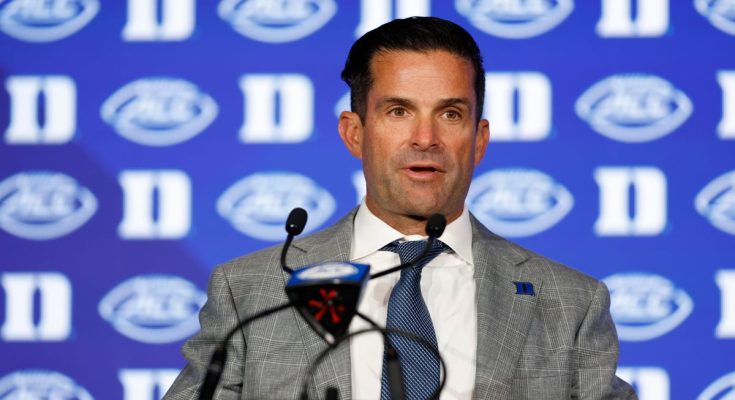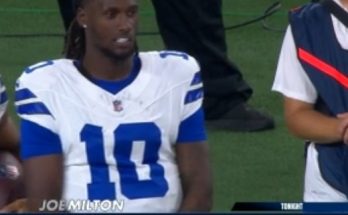Duke football is entering a new era, one filled with hope, expectation, and the tantalizing promise of success. At the center of this transformation is head coach Manny Diaz, a seasoned tactician with a reputation for defensive brilliance and a keen eye for talent. Diaz’s challenge is clear: to take a program that has flirted with mediocrity and push it into consistent relevance in the fiercely competitive landscape of college football. His most potent weapon in this pursuit is Darian Mensah, the highly-touted quarterback transfer whose arrival has sparked both excitement and curiosity among Blue Devils fans. As the program looks ahead, the question is unavoidable: can Manny Diaz capitalize on Mensah’s talent and build a sustainable foundation of success at Duke?
Manny Diaz is no stranger to high expectations. Having served in various coaching capacities at top-tier programs, including stints as a defensive coordinator at Miami and Texas, Diaz brings a wealth of experience and a strategic mindset to Durham. His reputation has often been built on his defensive acumen, yet the transition to leading a program as head coach requires a broader skill set—one that encompasses recruitment, player development, game management, and the cultivation of a winning culture. In recent seasons, Diaz has made noticeable strides in building a disciplined, competitive squad at Duke, signaling that the Blue Devils may finally be poised to escape the shadow of perennial underperformance in the ACC.
The addition of Darian Mensah adds an entirely new dimension to this undertaking. Mensah, a quarterback known for his dual-threat capabilities, combines arm strength with mobility, providing Diaz with a dynamic offensive weapon capable of challenging defenses in multiple ways. For Duke, a program historically not recognized for quarterback depth or explosive offensive production, Mensah’s arrival could be a game-changer. His ability to extend plays, make accurate throws on the move, and read defenses quickly allows Diaz to design schemes that maximize the talents of the entire roster. In many ways, Mensah represents both the present and the future of Duke football, a player around whom the team can build its offensive identity.
Yet, talent alone does not guarantee success. The history of college football is littered with programs that acquired star transfers only to see their potential squandered by systemic issues, lack of cohesion, or ineffective coaching. For Manny Diaz, the challenge lies not merely in installing Mensah into the starting role but in creating an environment that fosters his growth while simultaneously elevating the performance of his teammates. Football is, after all, the ultimate team sport; a quarterback, no matter how skilled, cannot carry a program single-handedly. Offensive line protection, receiving corps execution, running game balance, and coaching adaptability all converge to determine whether a quarterback can thrive and, by extension, whether a coach can build sustained success.
One of the first hurdles for Diaz and Mensah will be establishing chemistry with the offensive unit. Transfers often face an adjustment period, learning a new playbook, acclimating to new coaching philosophies, and integrating with teammates who have already formed bonds over previous seasons. For Mensah, mastering the nuances of Diaz’s offensive scheme and building trust with his receivers and offensive line will be critical. Success in this regard could translate into immediate on-field impact, but missteps or lingering uncertainties could slow the team’s momentum and expose vulnerabilities. The ability of Diaz to facilitate this transition, to act as both mentor and strategist, will be under the microscope throughout the early stages of the season.
Recruitment and talent development are also central to Diaz’s long-term vision. While Mensah provides a marquee presence, a single player cannot reshape a program alone. Diaz must leverage Mensah’s skills to attract additional recruits who see the potential for growth and exposure within Duke’s system. Quarterbacks, receivers, and offensive linemen are likely to be drawn by the prospect of playing alongside a dynamic signal-caller capable of producing highlight-reel plays. Similarly, defensive recruits will recognize the opportunity to contribute to a program on the rise, one guided by a head coach with a track record of defensive innovation. Success in recruitment will create a ripple effect, gradually elevating the overall talent level across the roster and positioning Duke to compete more consistently within the ACC.
The strategic deployment of Mensah within the team’s offensive scheme will be equally significant. Diaz has the ability to craft a system that maximizes Mensah’s dual-threat capability while maintaining offensive balance. Utilizing read-option plays, designed quarterback runs, and creative passing concepts, the Blue Devils can keep opposing defenses off balance. Mensah’s mobility also provides a built-in safety valve, allowing him to escape pressure and extend plays that would otherwise result in negative outcomes. Yet, this flexibility must be carefully managed; overreliance on quarterback improvisation can lead to turnovers and injury risk. Diaz’s task is to strike a balance between harnessing Mensah’s natural instincts and maintaining disciplined execution that reduces errors and sustains offensive rhythm.
Equally important is the cultural and leadership aspect of Mensah’s presence. As a high-profile transfer, he will inevitably attract attention both on and off the field. How he navigates this spotlight, sets the tone for teammates, and embodies the values of the program will impact team cohesion. Manny Diaz has the opportunity to guide Mensah not only as a player but as a leader, helping him channel his influence to inspire confidence and accountability among the roster. A quarterback who leads by example, communicates effectively, and demonstrates resilience under pressure can galvanize a team in ways that extend far beyond raw statistics. In this sense, Mensah’s development into a complete leader is as vital as his physical performance.
Beyond the individual and positional considerations, the broader ACC landscape presents both opportunities and challenges. The conference is home to some of the most competitive programs in the nation, with powerhouses boasting deep rosters, elite coaching staffs, and storied traditions. Duke’s path to prominence is not guaranteed, and incremental gains may be necessary before the program can realistically contend for conference titles. Strategic scheduling, adaptive game planning, and the ability to win close contests will all factor into the measure of Diaz’s success. Mensah’s performance in high-pressure ACC matchups will be particularly telling, as it will indicate whether the Blue Devils can compete consistently against elite competition or remain on the fringes of the conference hierarchy.
In evaluating Diaz’s prospects, it is also important to consider the institutional context. Duke is renowned for its academic rigor, and football players must balance the demands of coursework, travel, and practice. Building a winning program within this framework requires patience, attention to detail, and an appreciation for the unique pressures faced by student-athletes. Diaz’s approach to integrating Mensah into this environment, providing support while maintaining competitive expectations, will influence the overall trajectory of the program. Success at Duke is as much about fostering a holistic culture as it is about accumulating wins on the scoreboard.
The stakes are high, but so too is the potential. With Manny Diaz at the helm and Darian Mensah under center, Duke football has the components necessary to redefine its identity. The combination of coaching expertise, quarterback talent, and a commitment to program-building represents a convergence of factors that could propel the Blue Devils to new heights. Fans, alumni, and stakeholders are eager to see whether this pairing can translate potential into measurable success, whether on the field through victories and championships or off the field through enhanced recruiting and national recognition.
Ultimately, the question of whether Manny Diaz can build on success with Darian Mensah transcends individual accomplishments. It is a test of vision, strategy, leadership, and adaptability. It challenges the Blue Devils to embrace a new standard of excellence and to recognize that sustained success requires more than flashes of brilliance—it demands consistency, resilience, and collective effort. Mensah provides the spark, Diaz provides the framework, and the team’s broader roster provides the foundation. Together, they have the opportunity to chart a course that transforms Duke football from a program of potential into a program of achievement, one game and one season at a time.
The upcoming seasons will reveal the answers. Observers will watch closely as the Blue Devils navigate the complexities of conference play, player development, and team dynamics. Every throw, every game plan, and every decision will be scrutinized as part of the broader narrative of Duke football’s evolution. Success will not be instantaneous, nor will it be without setbacks, but the combination of Manny Diaz’s coaching acumen and Darian Mensah’s quarterback talent offers a compelling blueprint for progress. If executed effectively, it could signal a new chapter in which Duke emerges as a legitimate contender, challenging traditional power structures within the ACC and rewriting expectations for what the program can achieve.
In the end, Duke football’s future rests on more than hope—it rests on deliberate action, cohesive strategy, and the ability to turn talent into tangible results. Manny Diaz has shown the capacity to lead, and Darian Mensah has demonstrated the skill to perform at a high level. Their partnership represents an opportunity to create something meaningful, a program capable of consistent success and national recognition. The journey will be challenging, the margin for error slim, and the competition fierce, but the potential rewards are substantial. For Duke, the combination of Diaz and Mensah is more than a roster update—it is a chance to redefine the trajectory of a football program, to instill pride in its supporters, and to leave a lasting legacy in the annals of college football. The question remains: can Manny Diaz harness this opportunity and turn promise into reality? The coming seasons will provide the answer, and the eyes of the Blue Devils faithful are fixed firmly on the horizon.



